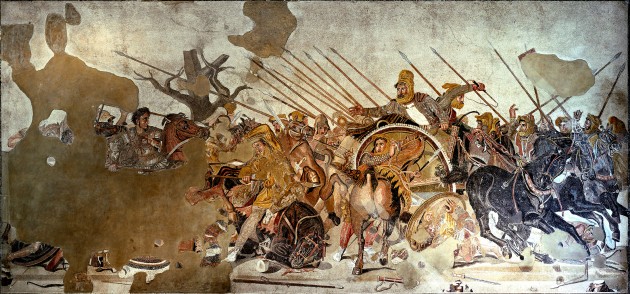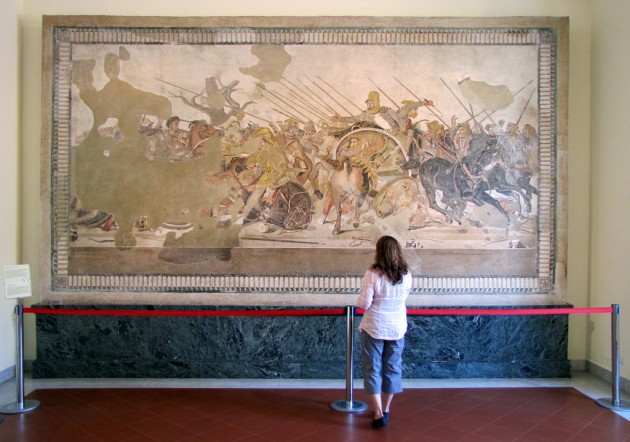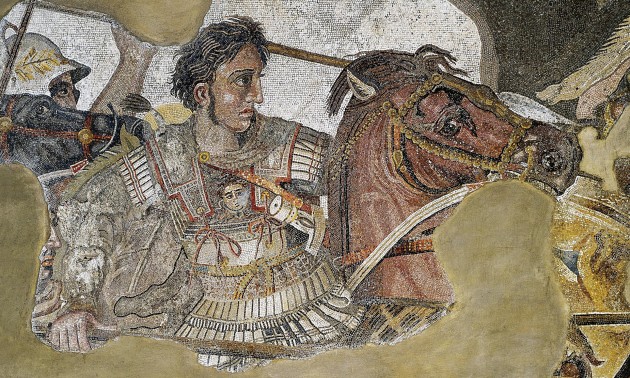Wednesday, May 24th, 2017
The Alexander Mosaic: Originality, Copies, and Displays

Alexander the Great Confronts Darius III at the Battle of Issos (or possibly Battle of Gaugamela), floor mosaic, House of the Faun at Pompeii, Italy. 1st century CE Roman copy of a Greek wall painting of c. 310 BCE, perhaps by Philoxenos or Eretria or Helen of Egypt. Entire panel 8’10” x 17′ (2.7 x 5.2 m). National Archaeological Museum, Naples. Image courtesy Wikipedia
Yesterday one of my students gave a presentation on the Alexander mosaic from Pompeii. The student mentioned having a chance to visit the House of the Faun when he was younger, and showed the class an image of his younger self at the site. The House of the Faun is most important surviving house from Pompeii, and originally it was so large that it comprised a whole city block!
Today, the Alexander mosaic in the House of the Faun is a copy and the original mosaic is located in the National Archaeological Museum in Naples. The original mosaic was discovered at the House of the Faun in 1831; it was located on the floor of the exedra, which is a rectangular room off of the first peristyle court. This indicates that guests would have seen this mosaic when they came to visit with the owner of the house in the exedra space. In order to better preserve the Alexander mosaic, it was moved to the National Archaeological Museum of Naples in 1843.

Alexander Mosaic display at the National Archaeological Museum in Athens. Image courtesy Steven Zucker via Flickr and Creative Commons license.
My student’s presentation reminded me of a lecture that Dr. Diana Kleiner gave on Pompeii, in which she discussed the Alexander mosaic (see 47:10 – 54:00 of this video clip). In her lecture, Diana Kleiner expressly points out how the museum displays the mosaic on the wall, which is inaccurate to the original placement of the floor mosaic. I can see her point, especially since the museum display tries to replicate the exedra of the House of the Faun (where the mosaic originally appeared). However, I also don’t mind that the mosaic currently is on the wall, because it can also serve as a reminder of how the original mosaic itself is a copy of a now-lost Greek wall painting from the beginning of the Hellenistic period in Ancient Greece (probably from c. 310 BCE, which is just a few years after the death of Alexander the Great in 323 BCE).

Alexander mosaic replica, c. 2003-2005. House of the Faun, Pompeii. Image courtesy Steven Zucker via Flickr and Creative Commons license.
A copy of the Alexander mosaic was placed in the House of the Faun in 2005. The process of creating this replica was daunting, since the large mosaic is comprised of over two million pieces of tesserae.1 The project took 16,000 hours of work and cost $216,000.2 So, in essence, this replica is a modern copy of a Roman copy of an original Greek painting.

Detail of original Alexander the Great mosaic, 1st century CE Roman copy of a Greek wall painting of c. 310 BCE.
Both the mosaic replica and the original mosaic are impressive in their own right. Diana Kleiner makes a good point in her lecture, too, about how the original Alexander mosaic is perhaps even more impressive than the original painting, since illusionism and foreshortening appear with small pieces of stone instead of pigment (see 50:11-51:19). It is unsure whether this floor mosaic was created by a Roman or Greek artist, but the translation of the imagery into mosaic form shows a high level of technique and precision!3
1 Ada Cohen, The Alexander Mosaic: Stories of Victory and Defeat (Cambridge: Cambridge University Press, 2000), 1.
2 Marco Merola, “Alexander, Piece by Piece,” from Archaeology Magazine 59, no 1 (2006). Available online at: http://archive.archaeology.org/0601/abstracts/mosaic.html
3 It is possible that this mosaic was created by a Greek artist who worked in the Roman empire in the 1st century. We know of other Greek artists who created mosaics for the Romans. For example, in the 2nd century a Greek mosaicist named Herakleitos worked in Rome and created “The Unswept Floor” mosaic that is currently in the Museo Gregoriano Profano (Musei Vaticani). This mosaic is signed by Herakleitos: ΗΡΑΚΛΙΤΟΣ ΗΡΓΑΣΑΤΟ
Love this post because as an AP Art History teacher we are always talking about art in situ versus how museums currently display them. As someone who has seen both the museum and the Pompeii replica, I don’t mind the mosaic on the wall. It allows the audience to see all the detail better. However, I wonder if any of the perspective was adjusted for its “original” position on the floor.
Hi Jessica! Thanks for your comment! I also have my college students analyze the difference between original (in situ) context and the curated context of a museum display. In fact, I just assigned them to visit our local museum and they are writing analytical essays on this topic right now!
It would be interesting to determine if the Romans made adjustments to this floor mosaic. If only the original painting had survived! Regardless, I think it would be a very different experience to stand on top of (and look down at) those foreshortened features in the mosaic, as opposed to looking at them straight-on.
An excellent post as usual, thank you! Just a note on your concluding remark: most probably, the mosaicist who made the copy in the Roman era was also Greek 🙂
Hi Greg! Thanks for your comment and your kind words! I hadn’t considered how a Greek might have been the mosaicist, but that makes sense. I modified the last part of my post accordingly, and also put a footnote at the end to give more context regarding Greek mosaicists who worked in ancient Rome.
There’s also a mosaic in the same museum that’s supposed to be a copy of the legendary painting of Venus Anadyomene by Apelles. It’s one of the very few images that’s survived intact from antiquity to the present
Hi Heidenkind! I didn’t realize that was at the same museum. I saw that painting of Venus Anadyomene a few years ago, in a traveling exhibition about Pompeii, and I remember being really excited to see it in person. I didn’t even realize that the objects in the show were from the National Archaeological Museum in Naples, but your comment led me to go back and verify the lender for the exhibit. I now feel especially lucky that I got a chance to see this traveling show on Pompeii! http://artdaily.com/news/88982/Artworks-from-Naples-national-archaeological-museum-to-go-on-tour-in-the-United-States#.WUC6qGjythF